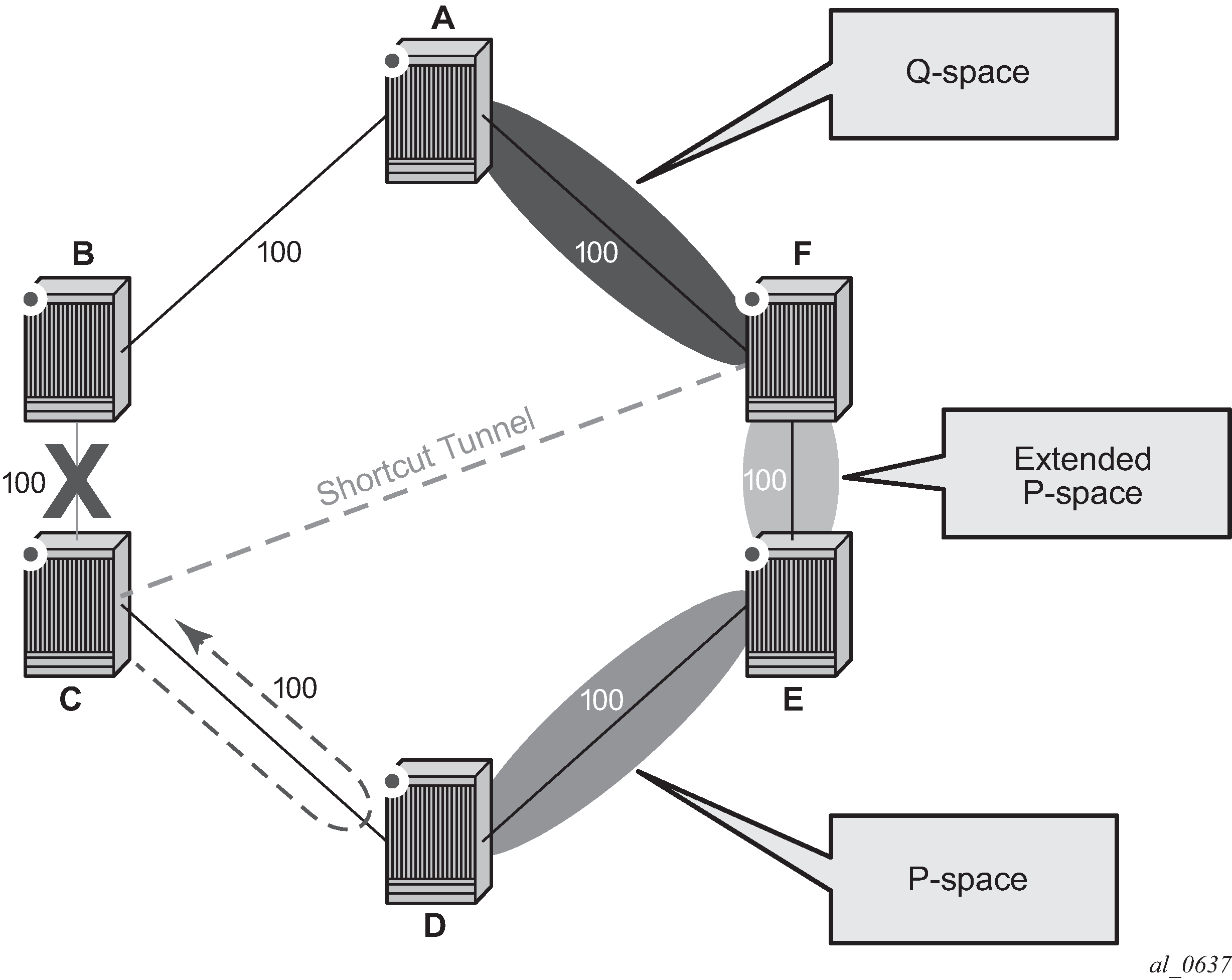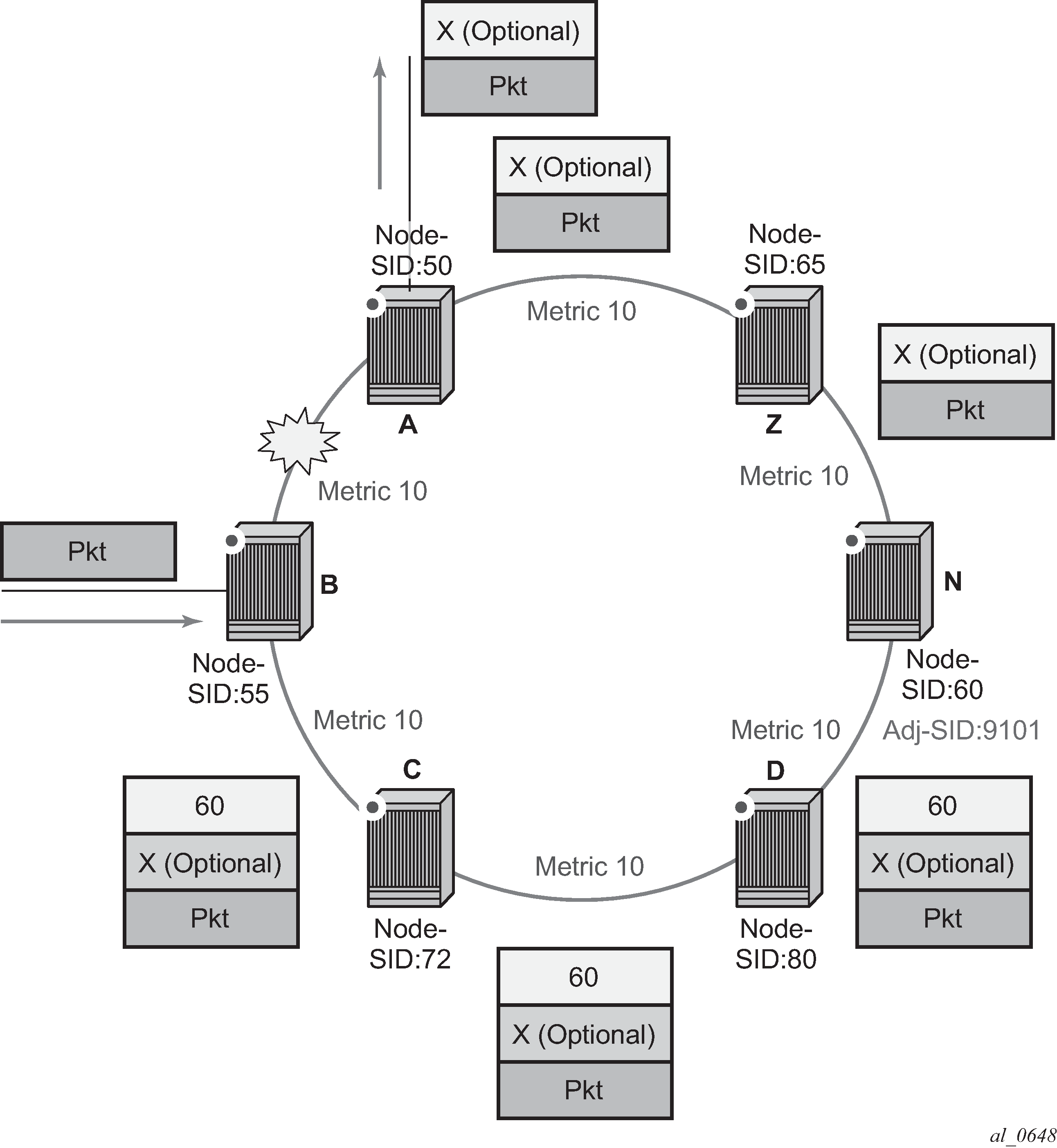The user enables the remote LFA next-hop calculation by the IGP LFA SPF by appending the following new option in the existing command which enables LFA calculation:
config>router>isis>loopfree-alternates remote-lfa
config>router>ospf>loopfree-alternates remote-lfa
SPF performs the remote LFA additional computation following the regular LFA next-hop calculation when both of the following conditions are met:
-
The remote-lfa option is enabled in an IGP instance.
-
The LFA next hop calculation did not result in protection for one or more prefixes resolved to a given interface.
Remote LFA extends the protection coverage of LFA-FRR to any topology by automatically computing and establishing/tearing-down shortcut tunnels, also referred to as repair tunnels, to a remote LFA node which puts the packets back into the shortest without looping them back to the node which forwarded them over the repair tunnel. A repair tunnel can in theory be an RSVP LSP, an LDP-in-LDP tunnel, or an SR tunnel. In SR OS, this feature is restricted to use an SR repair tunnel to the remote LFA node.
The remote LFA algorithm for link protection is described in RFC 7490, Remote Loop-Free Alternate (LFA) Fast Reroute (FRR). Unlike the regular LFA calculation, which is calculated per prefix, the LFA algorithm for link protection is a per-link LFA SPF calculation. As such, it provides protection for all destination prefixes which share the protected link by using the neighbor on the other side of the protected link as a proxy for all these destinations. Assume the topology in Figure 1.

When the LFA SPF in node C computes the per-prefix LFA next-hop, prefixes which use link C-B as the primary next-hop has no LFA next-hop due to the ring topology. If node C used node link C-D as a back-up next-hop, node D would loop a packet back to node C. The remote LFA then runs the following algorithm, referred to as the ‟PQ Algorithm” in RFC 7490:
-
Compute the extended P space of Node C with respect to link C-B: set of nodes reachable from node C without any path transiting the protected link (link C-B). This yields nodes D, E, and F.
The determination of the extended P space by node C uses the same computation as the regular LFA by running SPF on behalf of each of the neighbors of C.
Note: RFC 7490 initially introduced the concept of P space, which would have excluded node F because, from the node C perspective, node C has a couple of ECMP paths, one of which goes via link C-B. However, because the remote LFA next-hop is activated when link C-B fails, this rule can be relaxed and node F can be included, which then yields the extended P space.The user can limit the search for candidate P nodes to reduce the amount of SPF calculations in topologies where many eligible P nodes can exist. A CLI command is provided to configure the maximum IGP cost from node C for a P node to be eligible:
-
config>router>isis>loopfree-alternates remote-lfa max-pq-cost value
-
config>router>ospf>loopfree-alternates remote-lfa max-pq-cost value
-
-
Compute the Q space of node B with respect to link C-B: set of nodes from which the destination proxy (node B) can be reached without any path transiting the protected link (link C-B).
The Q space calculation is effectively a reverse SPF on node B. In general, one reverse SPF is run on behalf of each of C neighbors to protect all destinations resolving over the link to the neighbor. This yields nodes F and A in the example of Figure 1.
The user can limit the search for candidate Q nodes to reduce the amount of SPF calculations in topologies where many eligible Q nodes can exist. The CLI above is also used to configure the maximum IGP cost from node C for a Q node to be eligible.
-
Select the best alternate node: this is the intersection of extended P and Q spaces. The best alternate node or PQ node is node F in the example of Figure 1. From node F onwards, traffic follows the IGP shortest path.
If many PQ nodes exist, the lowest IGP cost from node C is used to narrow down the selection and if more than one PQ node remains, the node with lowest router-id is selected.
The details of the label stack encoding when the packet is forwarded over the remote LFA next-hop is shown in Figure 2.

The label corresponding to the node SID of the PQ node is pushed on top of the original label of the SID of the resolved destination prefix. If node C has resolved multiple node SIDs corresponding to different prefixes of the selected PQ node, it pushes the lowest node SID label on the packet when forwarded over the remote LFA backup next-hop.
If the PQ node is also the advertising router for the resolved prefix, the label stack is compressed in some cases depending on the IGP:
-
In IS-IS, the label stack is always reduced to a single label, which is the label of the resolved prefix owned by the PQ node.
-
In OSPF, the label stack is reduced to the single label of the resolved prefix when the PQ node advertised a single node SID in this OSPF instance. If the PQ node advertised a node SID for multiple of its loopback interfaces within this same OSPF instance, the label stack is reduced to a single label only in the case where the SID of the resolved prefix is the lowest SID value.
The following rules and limitations apply to the remote LFA implementation:
-
If the user excludes a network IP interface from being used as an LFA next-hop using the CLI command loopfree-alternate-exclude under the interface’s IS-IS or OSPF context, the interface is also excluded from being used as the outgoing interface for a remote LFA tunnel next-hop.
-
As with the regular LFA algorithm, the remote LFA algorithm computes a backup next-hop to the ABR advertising an inter-area prefix and not to the destination prefix itself.